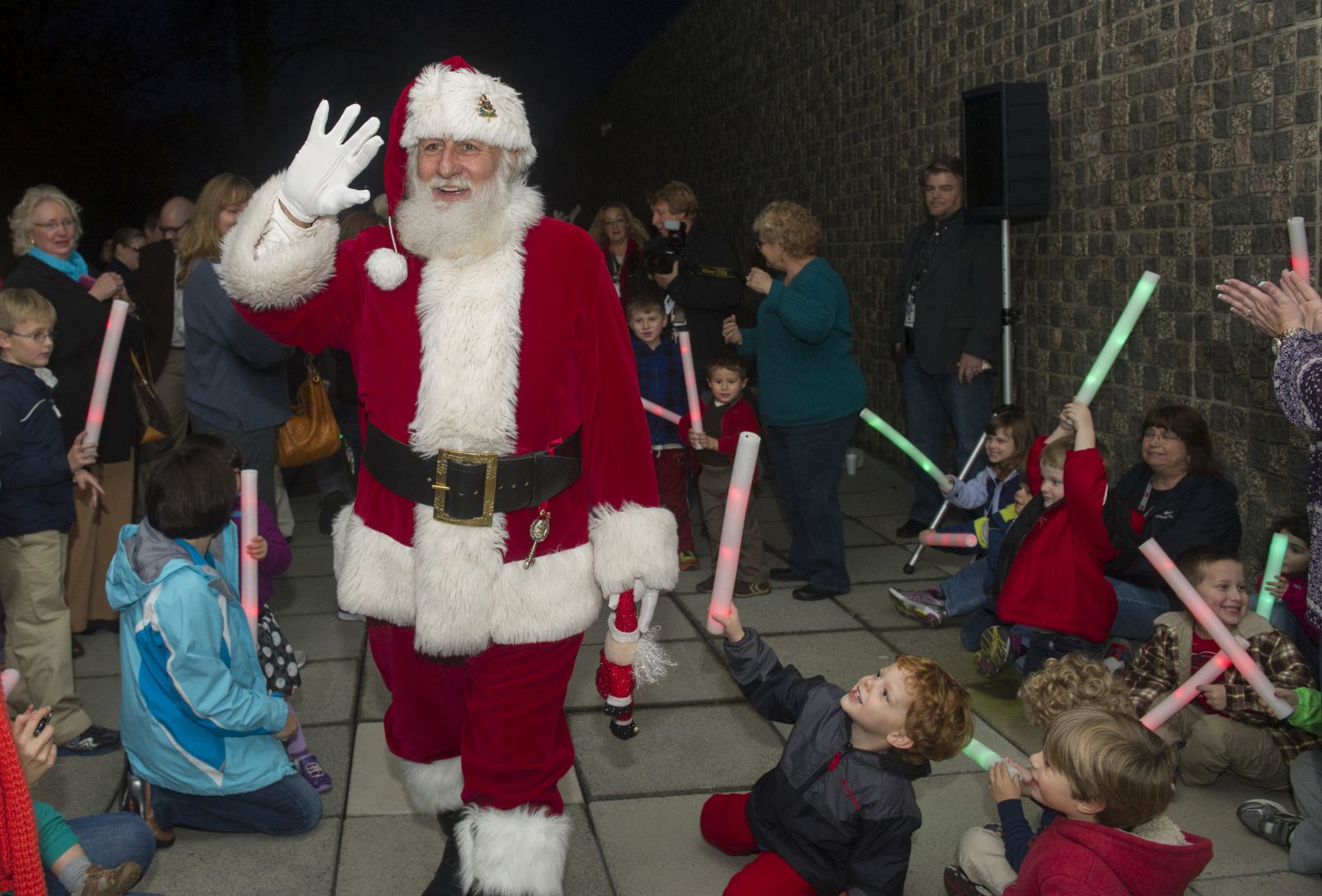In This Week’s Star
- Is BEAM the Future of Space Habitats?
- A Stellar Circle of Life
- Marshall Team Invited to Help Light Up Holiday Season at Dec. 1 Tree-lighting
- Marshall Celebrates Native American History Month
- This Week in NASA History: First Hubble-servicing Mission Launches — Dec. 2, 1993
- Rocket Hardware Stacking Featured on ‘This Week @NASA’
- Obituaries
Is BEAM the Future of Space Habitats?
Crew members on the International Space Station are helping with a technological demonstration of a compressed habitat segment that arrived in space folded up, was attached to the orbiting outpost earlier this year and expanded. A recent inspection of the module showed it is in good condition. Businessman Robert Bigelow sent his Bigelow Expandable Activity Module to the station in April 2016. In the next two years, astronauts will test BEAM and validate the overall performance of expandable habitats where crews could live and work. BEAM is an example of NASA partnering with industry to enable the growth of the commercial use of space. The space station, a test bed for demonstrating new technologies, is the springboard to NASA’s next great leap in exploration, including future missions to an asteroid and Mars. (NASA/MSFC)
A Stellar Circle of Life
A snapshot of the stellar life cycle has been captured in a new portrait from NASA’s Chandra X-ray Observatory and the Smithsonian’s Submillimeter Array. A cloud that is giving birth to stars has been observed to reflect X-rays from Cygnus X-3, a source of X-rays produced by a system where a massive star is slowly being eaten by its companion black hole or neutron star. This discovery provides a new way to study how stars form.
In 2003, astronomers used Chandra’s high-resolution X-ray vision to find a mysterious source of X-ray emission located very close to Cygnus X-3. The separation of these two sources on the sky is equivalent to the width of a penny at a distance of 830 feet away. In 2013, astronomers reported that the new source is a cloud of gas and dust.
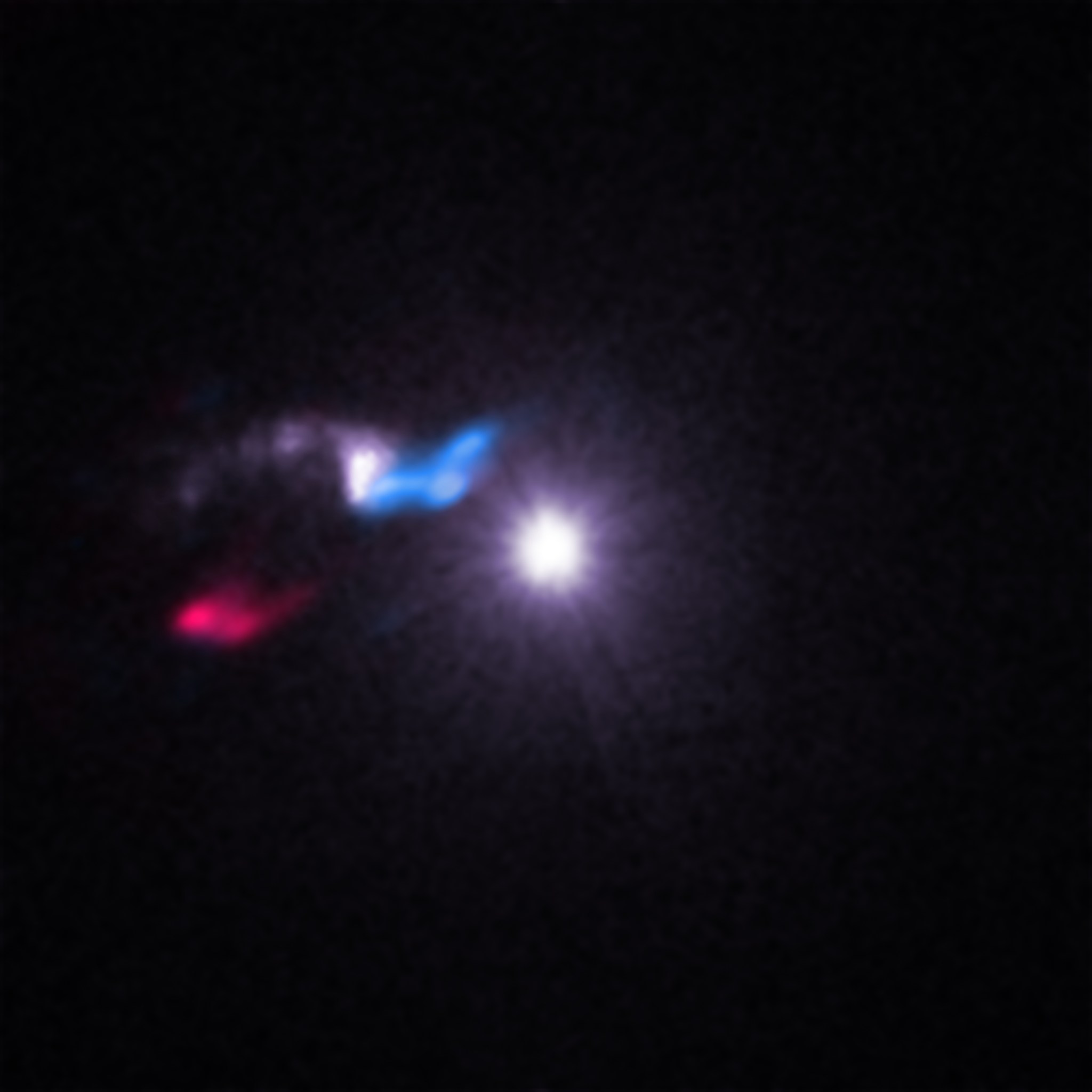
This composite image shows X-rays from NASA’s Chandra X-ray Observatory (white) and radio data from the Smithsonian’s Submillimeter Array (red and blue). The X-ray data reveal a bright X-ray source to the right known as Cygnus X-3, a system containing either a black hole or neutron star (a.k.a. a compact source) left behind after the death of a massive star. Within that bright source, the compact object is pulling material away from a massive companion star. Astronomers call such systems “X-ray binaries.”
In 2003, astronomers presented results using Chandra’s high-resolution vision in X-rays to identify a mysterious source of X-ray emission located very close to Cygnus X-3 on the sky (smaller white object to the upper left). The separation of these two sources is equivalent to the width of a penny about 800 feet away. A decade later, astronomers reported the new source is a cloud of gas and dust. In astronomical terms, this cloud is rather small – about 0.7 light years in diameter or under the distance between the Sun and Pluto’s orbit.
Astronomers realized that this nearby cloud was acting as a mirror, reflecting some of the X-rays generated by Cygnus X-3 towards Earth. They nicknamed this object the “Little Friend” due to its close proximity to Cygnus X-3 on the sky and because it also demonstrated the same 4.8-hour variability in X-rays seen in the X-ray binary.
To determine the nature of the Little Friend, more information was needed. The researchers used the Submillimeter Array (SMA), a series of eight radio dishes atop Mauna Kea in Hawaii, to discover the presence of molecules of carbon monoxide. This is an important clue that helped confirm previous suggestions that the Little Friend is a Bok globule, small, dense, very cold clouds where stars can form. The SMA data also reveal the presence of a jet or outflow within the Little Friend, an indication that a star has started to form inside. The blue portion shows a jet moving towards us and the red portion shows a jet moving away from us.
These results were published in The Astrophysical Journal Letters, and the paper is also available online. NASA’s Marshall Space Flight Center in Huntsville, Alabama, manages the Chandra program for NASA’s Science Mission Directorate in Washington. The Smithsonian Astrophysical Observatory in Cambridge, Massachusetts, controls Chandra’s science and flight operations. Credits: X-ray: NASA/CXC/SAO/M.McCollough et al, Radio: ASIAA/SAO/SMA
In astronomical terms, this cloud is rather small — about 0.7 light years in diameter. Astronomers realized that this cloud was acting as a mirror, reflecting some of the X-rays generated by Cygnus X-3 toward Earth.
“We nicknamed this object the ‘Little Friend’ because it is a faint source of X-rays next to a very bright source that showed similar X-ray variations,” said Michael McCollough of the Harvard-Smithsonian Center for Astrophysics in Cambridge, Massachusetts, who led the most recent study of this system.
The Chandra observations reported in 2013 suggested that the Little Friend had a mass between 2-24 times that of the sun. This suggested that the cloud was a “Bok globule,” a small dense cloud where infant stars can be born. However, more evidence was needed.
To determine the nature of the Little Friend, astronomers used the Smithsonian’s Submillimeter Array, a series of eight radio dishes atop Mauna Kea in Hawaii. The SMA found molecules of carbon monoxide, an important clue that the Little Friend is indeed a Bok globule. Also, the data reveal the presence of a jet or outflow within the Little Friend, an indication that a star has started to form inside.
“Typically, astronomers study Bok globules by looking at the visible light they block or the radio emission they produce,” said co-author Lia Corrales of the Massachusetts Institute of Technology in Cambridge. “With the Little Friend, we can examine this interstellar cocoon in a new way using X-rays — the first time we have ever been able to do this with a Bok globule.”
At an estimated distance of almost 20,000 light years from Earth, the Little Friend is also the most distant Bok globule yet seen.
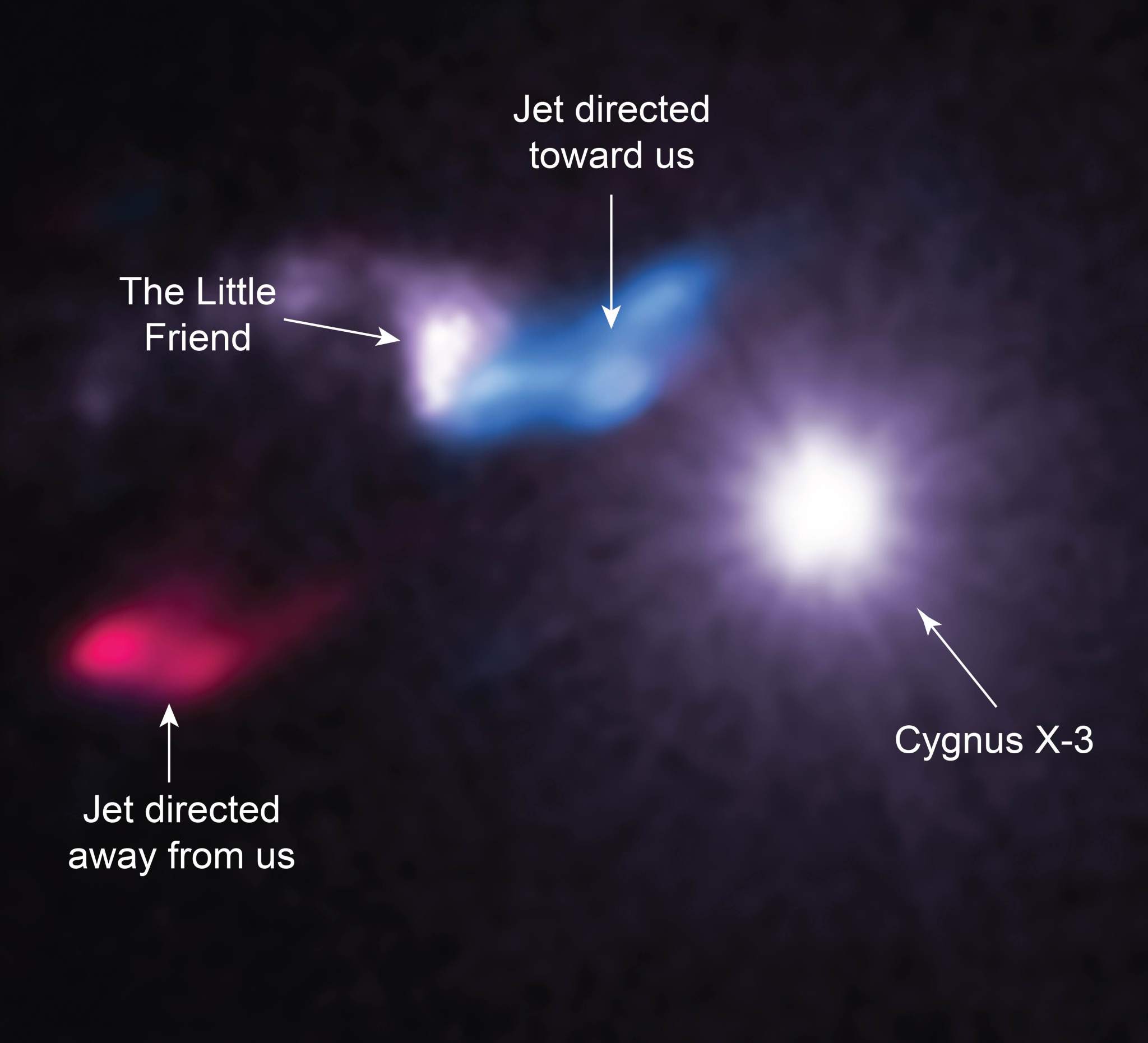
This composite image shows X-rays from NASA’s Chandra X-ray Observatory (white) and radio data from the Smithsonian’s Submillimeter Array (red and blue). The X-ray data reveal a bright X-ray source to the right known as Cygnus X-3, a system containing either a black hole or neutron star (a.k.a. a compact source) left behind after the death of a massive star. Within that bright source, the compact object is pulling material away from a massive companion star. Astronomers call such systems “X-ray binaries.”
In 2003, astronomers presented results using Chandra’s high-resolution vision in X-rays to identify a mysterious source of X-ray emission located very close to Cygnus X-3 on the sky (smaller white object to the upper left). The separation of these two sources is equivalent to the width of a penny about 800 feet away. A decade later, astronomers reported the new source is a cloud of gas and dust. In astronomical terms, this cloud is rather small – about 0.7 light years in diameter or under the distance between the Sun and Pluto’s orbit.
Astronomers realized that this nearby cloud was acting as a mirror, reflecting some of the X-rays generated by Cygnus X-3 towards Earth. They nicknamed this object the “Little Friend” due to its close proximity to Cygnus X-3 on the sky and because it also demonstrated the same 4.8-hour variability in X-rays seen in the X-ray binary.
To determine the nature of the Little Friend, more information was needed. The researchers used the Submillimeter Array (SMA), a series of eight radio dishes atop Mauna Kea in Hawaii, to discover the presence of molecules of carbon monoxide. This is an important clue that helped confirm previous suggestions that the Little Friend is a Bok globule, small, dense, very cold clouds where stars can form. The SMA data also reveal the presence of a jet or outflow within the Little Friend, an indication that a star has started to form inside. The blue portion shows a jet moving towards us and the red portion shows a jet moving away from us.
These results were published in The Astrophysical Journal Letters, and the paper is also available online. NASA’s Marshall Space Flight Center in Huntsville, Alabama, manages the Chandra program for NASA’s Science Mission Directorate in Washington. The Smithsonian Astrophysical Observatory in Cambridge, Massachusetts, controls Chandra’s science and flight operations. Credits: X-ray: NASA/CXC/SAO/M.McCollough et al, Radio: ASIAA/SAO/SMA
The properties of Cygnus X-3 and its proximity to the Little Friend also give an opportunity to make a precise distance measurement — something that is often very difficult in astronomy. Since the early 1970s, astronomers have observed a regular 4.8-hour variation in the X-rays from Cygnus X-3. The Little Friend, acting as an X-ray mirror, shows the same variation, but slightly delayed because the path the reflected X-rays take is longer than a straight line from Cygnus X-3 to Earth.
By measuring the delay time in the periodic variation between Cygnus X-3 and the Little Friend, astronomers were able to calculate the distance from Earth to Cygnus X-3 of about 24,000 light years.
Because Cygnus X-3 contains a massive, short-lived star, scientists think it must have originated in a region of the galaxy where stars are still likely to be forming. These regions are only found in the Milky Way’s spiral arms. However, Cygnus X-3 is located outside any of the Milky Way’s spiral arms.
“In some ways it’s a surprise that we find Cygnus X-3 where we do,” said co-author Michael Dunham of the Harvard-Smithsonian Center for Astrophysics and the State University of New York at Fredonia. “We realized something rather unusual needed to happen during its early years to send it on a wild ride.”
The researchers suggest that the supernova explosion that formed either the black hole or neutron star in Cygnus X-3 kicked the binary system away from its original birthplace. Assuming that Cygnus X-3 and the Little Friend formed near each other, they estimate that Cygnus X-3 must have been thrown out at speeds between 400,000 and 2 million miles per hour.
A paper describing these results appeared in a recent issue of The Astrophysical Journal Letters and is available online. NASA’s Marshall Space Flight Center manages the Chandra program for NASA’s Science Mission Directorate. The Smithsonian Astrophysical Observatory in Cambridge controls Chandra’s science and flight operations.
Marshall Team Invited to Help Light Up Holiday Season at Dec. 1 Tree-lighting
NASA’s Marshall Space Flight Center team members are encouraged to help usher in the holiday season Dec. 1 during Marshall’s annual holiday tree-lighting ceremony.
Set to begin at 4:45 p.m. on the front steps of Building 4200, the event will include remarks by Marshall Director Todd May and a musical performance by children from the Marshall Child Development Center. May then will welcome a jolly visitor from the North Pole to help light up Marshall’s holiday tree.
Children will have an opportunity to visit and take pictures with Saint Nick and an elf, while team members will be invited inside the lobby of 4200 for hot cocoa and cookies.
Redstone Arsenal also will hold its annual tree-lighting ceremony Dec. 1 from 4:30-7 p.m. at the Summit at Redstone, the arsenal’s conference center in Building 130 on Golf Course Road.
The Team Redstone event will include the lighting of a 25-foot tree, a variety of arts and crafts projects for children, holiday-themed treats and prize giveaways, a drop-off site for the U.S. Marines’ Toys for Tots campaign and a tour of Santa’s Workshop courtesy of Home Depot. Team Redstone includes Marshall and Army organizations on Redstone Arsenal.
Marshall Celebrates Native American History Month
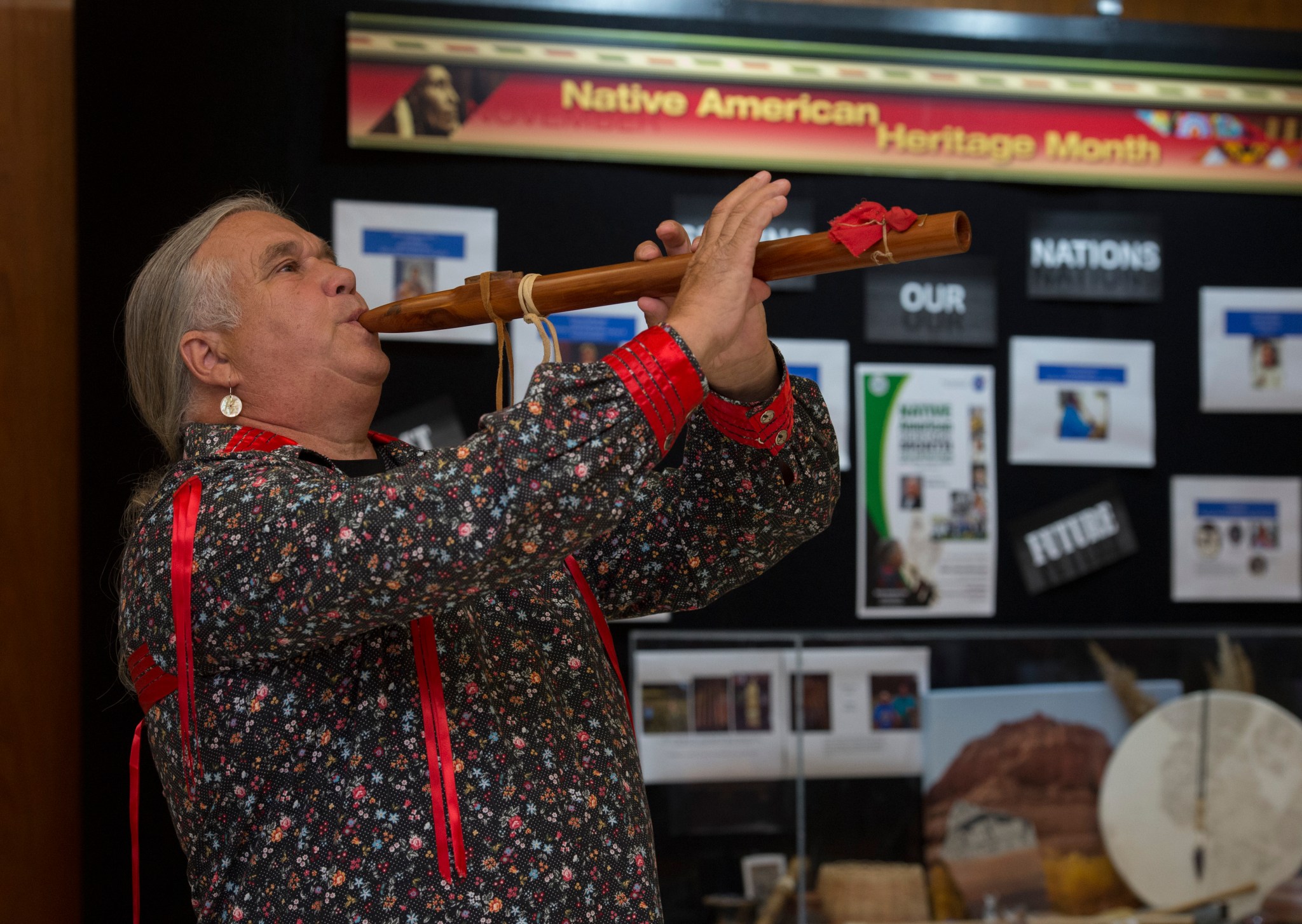
Jimmy Yellowhorse, a member of the Cherokee tribe, performs a traditional song during the Native American Heritage Month event at NASA’s Marshall Space Flight Center Nov. 29. This annual observance, coordinated by Marshall’s Office of Diversity and Equal Opportunity, honors the culture and contributions of Native Americans through storytelling, authentic musical performances and ethnic food sampling. Robbie Hood, a Native American who is an atmospheric scientist and director of the National Oceanographic and Atmospheric Administration’s Unmanned Aircraft Systems Program, provided the event’s keynote address. Prior to her NOAA appointment in 2008, Hood worked in Marshall’s Earth Science Office. (NASA/MSFC/Emmett Given)
This Week in NASA History: First Hubble-servicing Mission Launches — Dec. 2, 1993
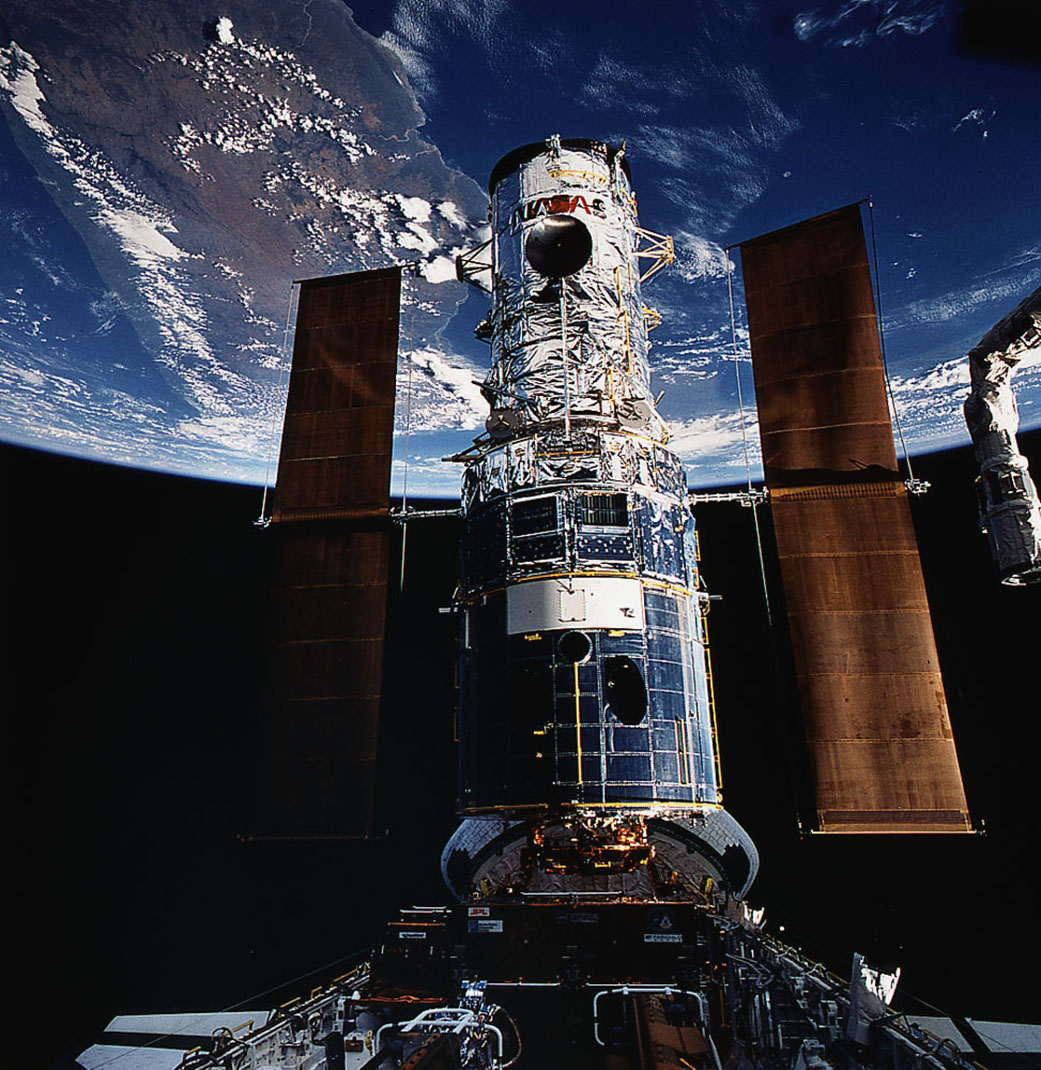
This week in 1993, space shuttle Endeavour launched from NASA’s Kennedy Space Center for the first servicing mission of the Hubble Space Telescope, STS-61. Here, astronauts berth Hubble in Endeavour’s cargo bay following its capture for repair. NASA’s Marshall Space Flight Center has been involved in development of many of the agency’s optical instruments. Notably, Marshall played a significant role in NASA’s Great Observatories, managing the development of Hubble and the Chandra X-ray Observatory, and the Burst and Transient Source Experiment for the Compton Gamma Ray Observatory. Marshall also manages Chandra’s flight, current operations and guest science observer program and has played a significant role in the testing of Hubble’s successor, the James Webb Space Telescope. Scheduled to launch in October 2018, the Webb telescope will observe the most distant objects in the universe, provide images of the first galaxies formed and see unexplored planets around distant stars. The NASA History Program is responsible for generating, disseminating, and preserving NASA’s remarkable history and providing a comprehensive understanding of the institutional, cultural, social, political, economic, technological, and scientific aspects of NASA’s activities in aeronautics and space. For more pictures like this one and to connect to NASA’s history, visit the History Program’s webpage. (NASA)
Rocket Hardware Stacking Featured on ‘This Week @NASA’
The movement and stacking of a test version of the interim cryogenic propulsion stage for NASA’s Space Launch System is featured in the latest edition of “This Week @NASA,” a weekly video program broadcast nationwide on NASA-TV and posted online.
Engineers recently moved the test article to a test stand at NASA’s Marshall Space Flight Center where it will join two simulators and three other qualification articles of the upper part of the SLS. The stack will then be pushed, pulled and twisted by forces similar to those experienced in flight.
The ICPS is the propulsion stage that will give NASA’s Orion spacecraft the in-space push needed to fly beyond the moon before returning to Earth during the first flight of SLS and Orion in 2018. The stack’s testing is scheduled for 2017, after remaining test articles are moved and stacked.
SLS will be the most powerful rocket ever built for human missions to deep space with the Orion spacecraft, including NASA’s Journey to Mars. Marshall manages the SLS Program for the agency.
View this and previous episodes at “This Week @NASA” or at https://www.youtube.com/user/NASAtelevision.
Obituaries
Wanda M. Walter, 73, of Huntsville, died Nov. 27. She retired from the Marshall Center in 2004 as a program analyst.
Luther E. Powell, 86, of Birmingham, Alabama, died Nov. 23. He retired from the Marshall Center in 1988 as manager of the Space Station Projects Office. He is survived by his wife, Charlotte Powell.

























